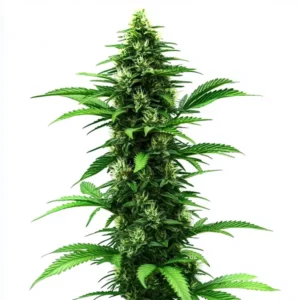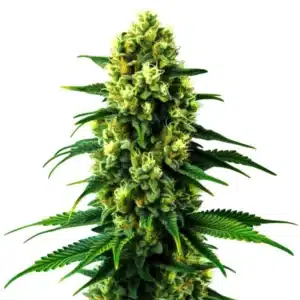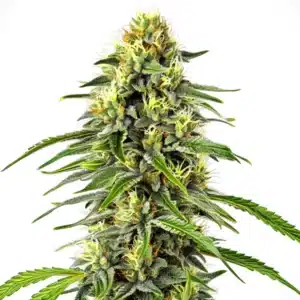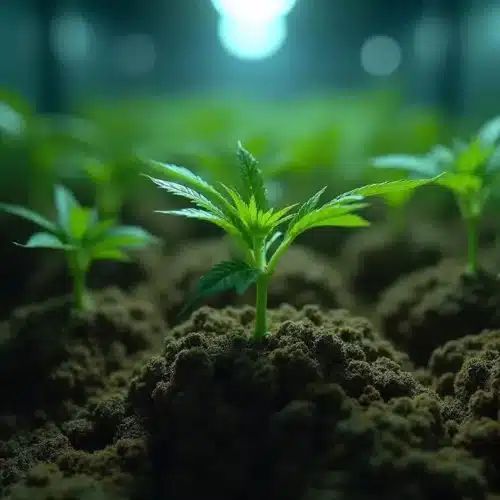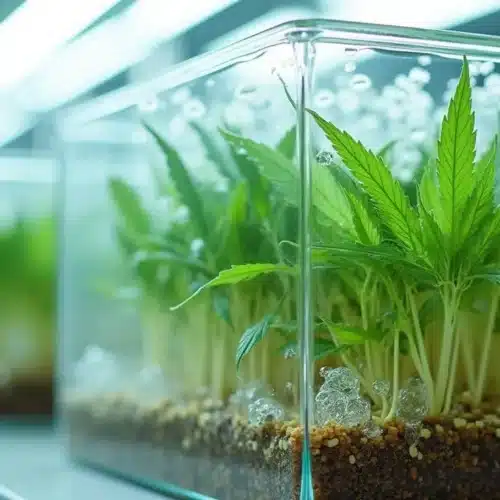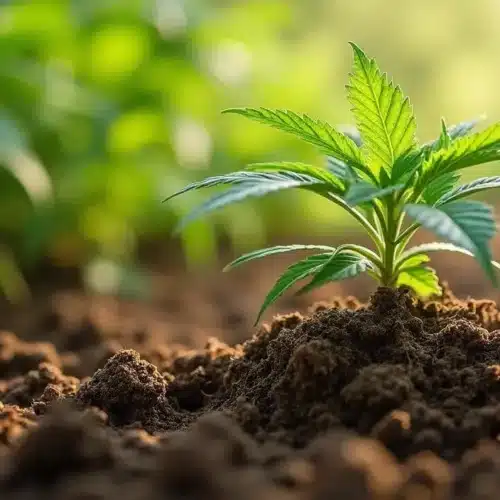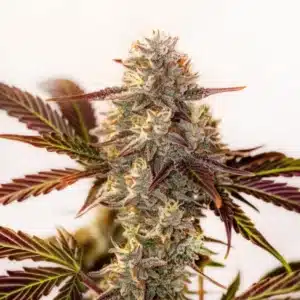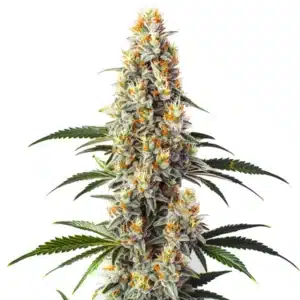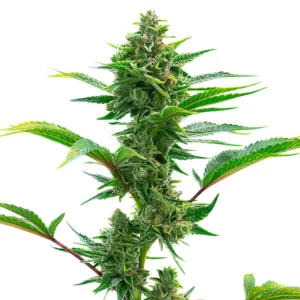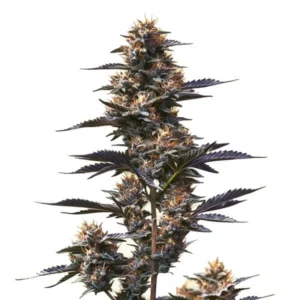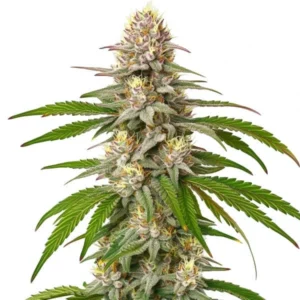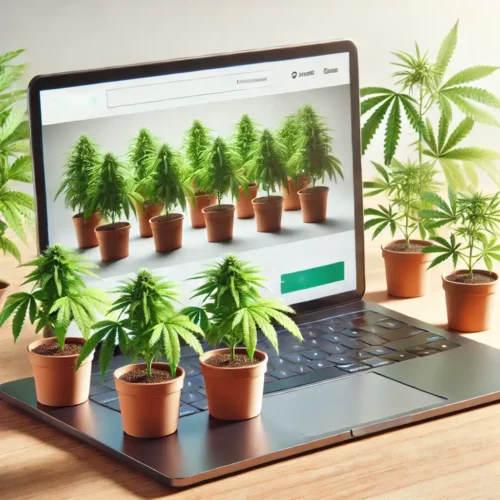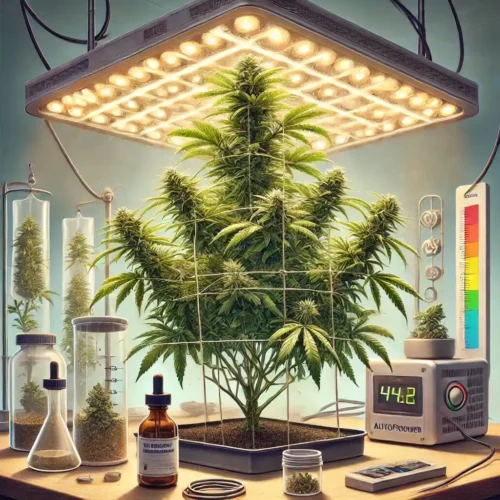Micro growing is an ideal solution for those with limited space or who prefer a discreet setup. This method allows you to grow cannabis in confined areas, such as cabinets, closets, or even computer towers. By carefully planning your space and optimizing the conditions, you can produce impressive results with minimal square footage. Micro growing isn’t just about fitting plants into small spaces—it’s about making the most out of every inch of your grow environment.
The key to success in micro growing lies in balancing the needs of the plant with the constraints of the space. This requires strategic choices in lighting, ventilation, strain selection, and training techniques. With the right approach, you can maximize your micro grow yield and achieve high-quality results even in unconventional spaces, without sacrificing the potency or quality of your cannabis plants.
What is Micro Growing?
Micro growing refers to the cultivation of cannabis plants in very small spaces. These confined areas are often repurposed from household items such as computer towers, old dressers, or even kitchen cabinets. The concept of micro growing revolves around maintaining the same principles as larger setups but adapted to fit tight quarters. The size of the space may be smaller, but with the right care, your plants can still thrive and produce excellent buds.
By focusing on maximizing efficiency and resource allocation, micro growing challenges growers to think creatively. Each element of the growing environment—light, temperature, humidity, and airflow—must be carefully managed to mimic the plant’s natural habitat, despite the spatial limitations. This method has become popular among urban growers and hobbyists who want to grow their own cannabis without needing large rooms or extensive equipment.
Promos & Deals
Benefits of Micro Growing
Space Efficiency
One of the main advantages of micro growing is the ability to grow cannabis plants in spaces where a traditional grow setup wouldn’t fit. Micro growing is especially valuable for individuals living in urban environments, apartments, or shared homes, where available space is often a constraint. You can convert small, unused spaces such as closets, cabinets, or even old PC towers into functional grow rooms. Despite the limited area, with the right planning, you can cultivate healthy plants that produce a respectable yield.
The small scale of micro growing also helps reduce the need for large, expensive equipment. For instance, you’ll need fewer lights, less ventilation, and reduced water usage compared to traditional setups. This helps minimize both the initial investment and ongoing operational costs. Additionally, the reduced size allows for easier maintenance, as you won’t have to deal with the complexity of managing multiple large plants.
Discreetness
Another key benefit of micro growing is how discreet the setup can be. Many growers opt for small-scale growing to avoid unwanted attention, whether it’s from landlords, roommates, or simply to maintain privacy. By repurposing common household items such as computer towers or cabinets, your grow setup blends into the background, making it far less likely to attract notice.
Moreover, the discreet nature of micro growing makes it an excellent choice for individuals living in areas with stricter legal regulations on cannabis cultivation. The ability to hide your grow area within everyday objects allows you to keep your activities low-key, which can be a big advantage in environments where stealth is important. Despite the small scale, micro growing setups can still produce enough cannabis for personal use, making it an efficient and covert option.

Setting Up Your Micro Growing Space
Choose Your Container
The first step in setting up a micro grow is selecting the right container or space. Popular choices include computer towers, cabinets, and small grow tents. Whatever you choose, make sure there’s enough room for your plants to grow both horizontally and vertically while maintaining adequate airflow. A computer tower, for example, can be an excellent choice for those looking for a compact and discreet option. After removing the internal components, you can line the inside with reflective material to help optimize light distribution.
When choosing your space, consider how you’ll manage the internal environment, including lighting, temperature, and humidity. Each of these factors will need to be carefully controlled to mimic the plant’s natural growing conditions. Reflective material, like Mylar, can be used to make the most of the available light, while small fans and heaters help regulate the temperature and airflow. Choosing a container that provides easy access to the plants is essential, as regular maintenance will be necessary to keep the plants healthy and thriving.
Lighting for Micro Growing
Proper lighting is essential in any cannabis grow, but it’s especially critical in micro growing due to the confined space. LED lights are highly recommended as they emit less heat than other lighting options and come in compact designs that fit well in small spaces. These lights are energy-efficient and allow for the optimal distribution of light without overwhelming your plants with too much heat, which is particularly important in smaller environments where excess heat can become an issue.
LED lights designed specifically for growing cannabis often come with customizable spectrums for different growth stages, including vegetative and flowering phases. This allows you to adjust the light to match the specific needs of your plants at each stage of growth. In a micro grow, it’s also essential to position the light as close to the plants as possible without causing heat stress. The goal is to maximize light exposure while keeping temperatures within a safe range for plant growth.
Ventilation and Airflow
Ventilation is critical to maintaining a healthy micro growing environment. Even in small spaces, proper airflow ensures that your plants receive the necessary carbon dioxide for photosynthesis and helps regulate the temperature and humidity within the grow area. Installing small fans or repurposing PC fans can help keep the air moving, which is essential to preventing issues like mold or mildew, which are common in enclosed environments.
Beyond simple fans, it may be necessary to install an exhaust system to remove stale air and reduce the risk of heat buildup from the lights. Proper ventilation also helps keep pests at bay and promotes the overall health of your plants. Ensuring that your micro grow setup has a consistent flow of fresh air will prevent common problems associated with stagnant air, such as poor plant development or susceptibility to diseases.
Temperature and Humidity Control
Maintaining the right temperature and humidity levels is crucial in micro growing. Small spaces tend to heat up quickly, especially with the use of lights. Ideally, your grow space should remain within the range of 70-85°F (21-29°C) for optimal growth. Installing a thermometer and a small exhaust fan can help release excess heat and keep the temperature in check. For humidity, you should aim for 60-70% during the vegetative stage and reduce it to 40-50% during the flowering stage to avoid mold and mildew.
Temperature spikes and dips can be more extreme in small spaces, so monitoring these variables closely is key to successful micro growing. In some cases, adding small heating or cooling elements, such as a miniature heater or air conditioner, may be necessary to maintain consistent conditions. Proper insulation and air circulation can also help in maintaining an optimal growing environment for your cannabis plants.
Selecting the Right Strains for Micro Growing
When growing cannabis in small spaces, strain selection plays a key role in determining the success of your grow. Autoflowering strains are a popular choice for micro growing due to their compact size, fast flowering times, and the fact that they don’t rely on light cycles to begin flowering. These strains are generally shorter in stature, making them easier to manage in confined spaces, and they mature faster, allowing you to harvest sooner.
Choosing the right strain can also help you avoid potential issues with plant height and overgrowth, which can quickly become a problem in a cannabis micro grow. Look for strains that are bred specifically for small spaces, as they are typically more forgiving in terms of their growth patterns. Strains with minimal branching and a bushy growth habit are ideal, as they can be easily trained and shaped to fit within the confines of your grow area.
Top Strains for Micro Growing
- Wedding Cake x Zkittlez Autoflower
This autoflowering strain combines the best of Wedding Cake and Zkittlez, offering a compact size perfect for micro grows. It thrives in small spaces with minimal intervention and provides a flavorful, relaxing experience. With a rapid flowering time, this strain is ideal for growers looking for a quick turnaround in confined spaces. - Frosted Guava Autoflower
Known for its tropical flavors and manageable size, Frosted Guava Autoflower is another excellent choice for micro growing. This strain remains short and bushy, making it easy to train and shape within a small setup. Its resilience and fast flowering time make it a favorite among micro growers. - Sweet Afghan Delicious Autoflower F1
Sweet Afghan Delicious Autoflower F1 is perfect for growers seeking a sweet and earthy flavor profile. This autoflowering strain thrives in limited space, requiring minimal care while still producing a generous yield of resinous buds. Its sturdy structure makes it a reliable choice for micro growing. - Lemon Haze Autoflower F1
Lemon Haze Autoflower F1 offers a zesty, uplifting high in a small package. This strain’s compact size and rapid growth cycle make it a standout choice for micro growing. Its ability to thrive in confined spaces without compromising on quality ensures a rewarding grow for enthusiasts with limited room.
Training Techniques for Micro Growing
Training techniques are essential in micro growing to ensure your plants don’t outgrow their confined space. These methods help you manipulate the growth of your plants so that they remain within the limits of your setup while maximizing their yield potential. Training techniques are particularly useful in small spaces, as they allow you to control the shape and height of your plants without sacrificing the quality of the buds.
LST (Low Stress Training)
Low stress training involves gently bending and tying down the branches of your cannabis plant to encourage horizontal growth. This method helps to create an even canopy, which exposes more bud sites to light and can lead to higher yields in a small space. LST is especially useful in micro growing because it allows you to maximize the use of available light while preventing the plant from growing too tall.
By spreading out the branches horizontally, LST also improves airflow within the grow space, reducing the risk of mold or mildew. The key to successful LST is to be gentle when manipulating the plant to avoid causing damage or stress. This technique is ideal for autoflowering strains, which can be more sensitive to stress and typically respond well to gentle training methods.
Topping
Topping is a technique where the main stem of the plant is cut, causing the plant to grow two new main colas instead of one. This helps reduce the height of the plant and encourages bushier growth, which is ideal for micro growing. Topping can be especially effective when combined with LST, as it allows you to further shape the plant and control its growth within the confined space.
Topping should be done early in the plant’s vegetative stage, typically after the third or fourth set of leaves has developed. This allows the plant enough time to recover and redirect its energy towards lateral growth. The result is a more compact, bushy plant with multiple bud sites, which can significantly improve the overall yield in a micro grow setup.
ScrOG (Screen of Green)
The ScrOG method involves placing a screen above the plants and weaving the branches through it as they grow. This technique spreads the plant out horizontally, making the most of the available light and ensuring that every bud site is adequately illuminated. ScrOG is particularly effective in small spaces because it helps maintain a low canopy and allows you to maximize the yield from each plant.
The key to a successful ScrOG is to start early, training the plants to grow along the screen during the vegetative stage. As the plants continue to grow, the screen helps keep the branches spread out, allowing light to penetrate deeper into the canopy. This method is ideal for growers who want to maximize their yield without increasing the number of plants in their setup.
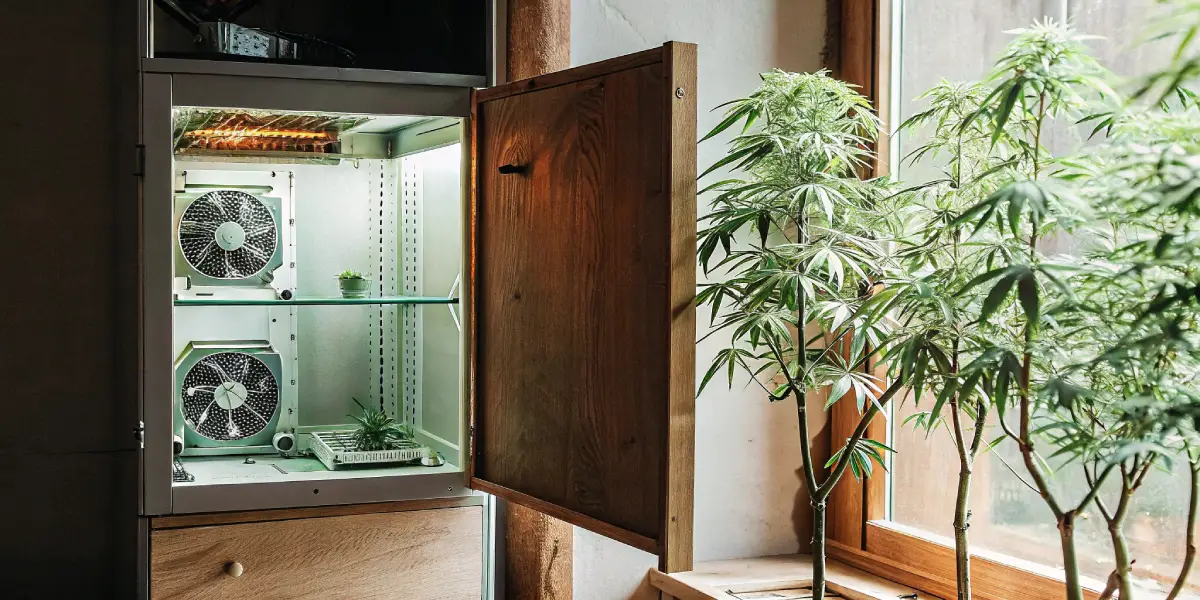
Nutrient Management in Micro Growing
Cannabis plants grown in micro environments still require the same nutrients as those in larger setups, but you’ll need to be more precise with your feedings. Overfeeding can be more detrimental in a confined space since the roots are limited and don’t have as much soil to buffer against nutrient excess. Carefully measuring and monitoring your plants’ nutrient intake is essential to avoid nutrient burn or other deficiencies that could impact your plants’ health and yield.
Nutrient requirements will vary depending on the strain, the growing medium, and the stage of growth. However, micro growers should aim to use smaller doses of nutrients than they would in larger setups to avoid overwhelming the plant’s root system. Maintaining a balance between nitrogen, phosphorus, and potassium throughout the grow is key to promoting healthy growth and strong bud development.
Organic vs Synthetic Nutrients
Organic nutrients are often preferred in micro grows due to their natural buffering capacity and their ability to maintain a healthy soil ecosystem. Organic fertilizers break down more slowly than synthetic options, providing a more gradual release of nutrients, which can help prevent overfeeding in small spaces. They also contribute to the development of beneficial microbes in the soil, which can improve the overall health of the plant.
On the other hand, synthetic nutrients offer more control and faster absorption, which can be beneficial in a small, fast-growing setup like micro growing. Synthetic nutrients are typically more concentrated, so it’s important to dilute them properly and avoid overapplication. Regardless of the type of nutrients you choose, maintaining a consistent feeding schedule and monitoring your plants closely will help ensure healthy growth and optimal yields.
Watering in Small Spaces
Micro growing spaces are prone to retaining moisture, which can lead to root rot and other problems if not managed carefully. Overwatering is one of the most common mistakes in micro growing, as smaller containers hold less soil and can become saturated quickly. It’s crucial to monitor your watering schedule closely, ensuring that the soil dries out between waterings to prevent overwatering.
One strategy to avoid overwatering is to use smaller pots, which tend to dry out more quickly than larger containers. This makes it easier to manage moisture levels and prevents the roots from sitting in soggy soil. Additionally, improving drainage by adding perlite or other materials to the soil mix can help ensure that excess water doesn’t accumulate in the root zone. Proper watering practices are essential for maintaining the health of your plants and preventing common issues like root rot or nutrient lockout.
Harvesting in a Micro Grow Setup
When it comes to harvesting in a micro grow, timing is everything. Since micro grows typically yield less than traditional setups, every gram counts. Harvesting too early or too late can significantly impact the potency and quality of your buds, so it’s important to monitor your plants closely as they approach maturity. Using a magnifying glass or jeweler’s loupe to check the trichomes on your buds can help you determine the optimal harvest time. Trichomes that appear cloudy or amber are a good indicator that your plants are ready to be harvested.
Once your plants are ready, it’s important to be gentle during the harvesting process to avoid damaging the delicate buds. Carefully trim away the leaves and hang the buds to dry in a dark, well-ventilated space. The drying process should be slow and controlled, typically taking 7 to 10 days, depending on the humidity and temperature of your drying space. A slower drying process allows the buds to retain their potency and flavor, resulting in a smoother, more enjoyable smoke.
Drying and Curing
Drying and curing your cannabis properly is just as important in micro growing as it is in larger grows. Once your buds have been trimmed, place them in a dark, well-ventilated area to dry. The drying process typically takes about 7 to 10 days, depending on the humidity and temperature of the environment. It’s important to maintain consistent airflow during the drying process to prevent mold from developing on the buds.
After the buds have dried, they should be cured in airtight containers for at least two weeks to enhance the flavor and potency. During the curing process, it’s important to “burp” the containers daily by opening them for a few minutes to release any built-up moisture. This allows the buds to continue drying slowly and evenly, which improves their overall quality and ensures a smoother smoke.
FAQs on Micro Growing
Can I grow regular photoperiod strains in a micro grow setup?
Yes, you can grow regular photoperiod strains in a micro grow setup, but it requires more management and control than autoflowering strains. Photoperiod strains are more dependent on light cycles to trigger flowering, so you’ll need to be able to manipulate the light schedule within your confined space. Additionally, photoperiod strains tend to grow larger than autoflowers, so you’ll need to implement training techniques like topping, LST, or ScrOG to keep them manageable in a small environment.
Photoperiod strains also tend to have a longer vegetative stage, which means they require more time before they start flowering. This can be beneficial if you want to spend extra time training and shaping your plants for maximum yield. However, it also means you’ll need to be more patient and willing to dedicate additional time to your grow. With the right strain and techniques, photoperiod plants can thrive in a micro grow setup, but for simplicity and faster results, many growers prefer starting with an autoflower micro grow due to its ease of use.
How many plants can I grow in a micro grow setup?
The number of plants you can grow in a micro grow setup depends largely on the size of your space and the type of strain you’re growing. Typically, micro growers will focus on cultivating one or two plants at a time to maximize the use of light and space. Trying to grow too many plants in a small area can lead to overcrowding, which negatively impacts airflow, light penetration, and ultimately, plant health.
If you’re working with a very small space, like a computer tower, it’s best to stick with one plant and focus on training techniques to maximize the yield from that single plant. In slightly larger spaces, like a closet or cabinet, you may be able to grow two or three plants, but you’ll need to be diligent about training and pruning to ensure each plant gets enough light and air circulation. The goal is to create an environment where each plant can thrive without competing for resources.
What is the average yield from a micro grow?
The average yield from a micro grow setup can vary depending on several factors, including the strain, the size of the space, the growing techniques used, and the skill level of the grower. On average, micro growers can expect to harvest between 10 to 50 grams of cannabis per plant, although yields can be higher with optimal conditions and careful management. Autoflowering strains typically produce smaller yields due to their compact size, but with the right setup, it’s possible to achieve respectable harvests.
The key to maximizing yield in a micro grow is to focus on optimizing every aspect of the growing environment. This includes providing the right amount of light, maintaining proper temperature and humidity levels, and using training techniques to encourage bud development. While micro grows may not produce the same quantity as larger setups, they can still yield high-quality cannabis that is perfect for personal use.
Micro growing is an innovative way to cultivate cannabis in small spaces while maintaining the quality of your buds. By carefully selecting strains, optimizing the grow environment, and applying training techniques, you can achieve impressive results even in the most confined areas. Whether you’re working with a PC tower or a closet, micro growing allows you to enjoy the rewards of cannabis cultivation, no matter the size of your space.


